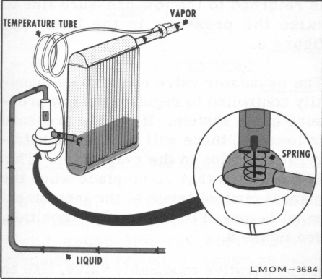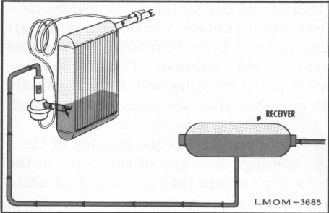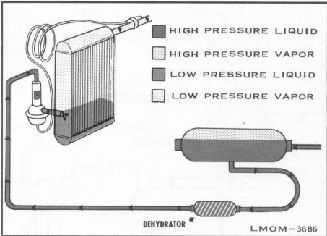


on the diaphragm which in turn permits a
coil spring
to force the needle towards its seat. This
action
reduces the liquid flow into the evaporator.
The result
is a slowing up of the refrigerating action
and a rise in
the temperature of the evaporator. See figure
5.
Fig. 5. Expansion Valve
From this it is obvious that if the expansion
valve
should stick in either the open or closed
position it
would cause a serious malfunction in the
system. In
the open position, the valve would allow
the Freon in
a liquid state to build up in the low pressure
side.
Eventually this liquid could be pumped into
the
compression chamber and rupture a head gasket,
or
break the check valves in the compressor
assembly.
In the closed position the expansion valve
would
cause practically all the Freon to be "Pumped
Down"
into the high pressure side of the system.
In this state
no refrigeration could take place.
Fig. 6. The Receiver
THE
DEHYDRATOR
A dehydrator is therefore placed in the
liquid line to
remove small amounts of moisture that may
have
been left in the system at the time of assembly.
See
figure 7.
Fig. 7. The Dehydrator
Also required in this refrigeration system
is a reservoir
or receiver. This unit receives the liquid
refrigerant
from the condenser and also holds a reserve
sup-ply
of fluid. See figure 6.
CAUTION: Extreme care should be used when
working on the refrigeration system to keep
moisture
or moist air from entering the system.
THE
RECEIVER
Moisture is one of the enemies of a refrigerating
system. If even a trace
of moisture circulates through
the system, it will materially reduce the
life of the
compressor and in severe cases moisture
will freeze
in the expansion valve and stop all refrigerating
action.
